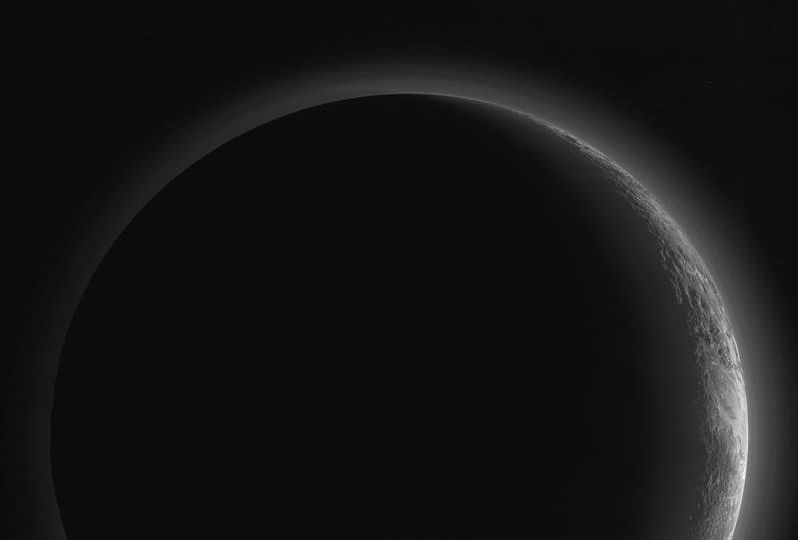
Dwarf planet Pluto
On August 24, 2006, the International Astronomical Union (IAU) announced it had re-classified Pluto as a dwarf planet. From 1930 until then, Pluto had been considered a normal planet and the outermost planet of the solar system. As technology had advanced, though, astronomers could see fainter objects. They began to recognize Pluto as the largest of multiple small bodies in the outer solar system. Now Pluto is known as a dwarf planet, and Neptune, 8th from the sun, is considered the outermost major planet. It all came about because the IAU had formulated a new definition of what it means to be a planet.
The public and even some astronomers didn’t initally take it lightly. Some declared they would still consider Pluto a planet. The word ‘plutoed‘ – meaning to demote or devalue something – entered the global lexicon. Nowadays, though, it seems most have accepted the logic of Pluto’s re-classification. Or at least we don’t hear as much of an uproar about it as we used to.
Why did Pluto change status?
Prior to 2006, astronomers hadn’t gotten around to establishing clear standards – such as a minimum size or mass, or other considerations – for categorizing a solar system “planet” versus a “dwarf planet.”
They began to see a need when many small bodies – such as Haumea and Makemake – began to be discovered in the outer solar system. Eris, also considered a dwarf planet, is even more massive than Pluto! So if Pluto is a planet, why shouldn’t Eris be granted planet status as well? That was the question the IAU asked itself, which led to its formation of a Planet Definition Committee and ultimately the 2006 decision.
The committee had a few possible roads to travel down. One would be to make the decision by size (or mass) so that Pluto would remain a planet, and therefore Eris and Ceres – the largest body in the asteroid belt in the inner solar system – would become planets, too. For a while, it looked as if that might happen with some IAU committee members favoring that decision.
Another option for the IAU might have been to define the concept of a planet without any specific logic: Earth is a planet, Pluto is a planet, but Eris is not just because.

New planetary classifications
So there were many new objects coming to light in the outer solar system. And, on August 24, 2006, the IAU announced its solution. It decided to create a scientific definition of what it means to be a planet. As a result, the definition excluded Pluto from major planet status. Here’s the definition:
A planet is a celestial body that
(a) is in orbit around the Sun,
(b) has sufficient mass for its self-gravity to overcome rigid body forces so that it assumes a hydrostatic equilibrium (nearly round) shape, and
(c) has cleared the neighborhood around its orbit.
It’s “c” that causes Pluto to fail as a planet, according to the IAU. For an object to be a major planet, according to this definition, it must be the dominant gravitational object in its orbit. It must either sling other objects away or merge with them.
Pluto is only 0.07 times the mass of the objects in its orbit. Meanwhile, Earth is 1.7 million times the mass of the objects in its orbit.

Pluto hasn’t cleared its neighborhood
On that fateful day – August 24, 2006 – the IAU also created a new category of celestial objects for Pluto and all Pluto-like objects:
A “dwarf planet” is a celestial body that
(a) is in orbit around the sun,
(b) has sufficient mass for its self-gravity to overcome rigid body forces so that it assumes a hydrostatic equilibrium (nearly round) shape,
(c) has not cleared the neighborhood around its orbit, and
(d) is not a satellite.
How many dwarf planets are there? According to this page by planetary astronomer Mike Brown of CalTech, as of May 5, 2023, there are:
10 objects which are nearly certainly dwarf planets,
27 objects which are highly likely to be dwarf planets,
68 objects which are likely to be dwarf planets,
130 objects which are probably dwarf planets, and
741 objects which are possibly dwarf planets.

Hundreds of dwarf planets?
Astronomers believe there may be hundreds more undiscovered dwarf planets in the Kuiper Belt of the outer solar system. There may be up to 10,000 in the region beyond.
Pluto is a planet pic.twitter.com/4GcJeCg3ax
— ? captain planet ??? (@titsoak) August 15, 2023
Not a new idea
By the way, it’s not common knowledge that many astronomers started out being quite careful about their use of the word “planet” with respect to Pluto. In 1932, for example, only two years after American astronomer Clyde Tombaugh discovered Pluto, another astronomer, Armin Otto Leuschner, wrote in a journal article:
You may observe that with extreme conservatism I am still referring to Pluto as an object rather than as a planet. There is every probability that it is a planet, as is now universally concluded, from available material … So far only an upper limit for the mass of Pluto … has been established, and such a mass is believed from gravitational considerations to be too small to affect the motions of Uranus and Neptune sufficiently … There is also a remote chance that later investigations will render its mass comparable to that of comets.
Pluto may have never been called a planet at all
Recall why astronomers began searching for Pluto in the first place. They expected to find an object large enough to gravitationally disturb the orbit of Neptune. If Pluto had been discovered a decade or so later, when Edgeworth speculated about the existence of the Kuiper Belt, it might have never been awarded the status of planet.
As it was, like it or not, Pluto became the world’s eye-opener when it came to the classification of solar system objects.
Bottom line: August 24 is the anniversary of Pluto’s demotion to dwarf planet status. The International Astronomical Union demoted Pluto largely because it is has not “cleared the neighborhood around its orbit.”











